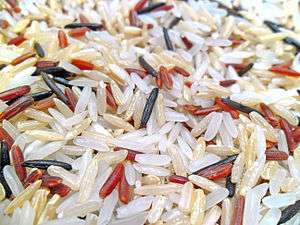Matta rice
Kerala Matta rice (also known as Rosematta rice, Palakkadan Matta rice, Kerala Red rice, or Red parboiled rice) (Malayalam: കേരള മട്ട) is an indigenous variety of rice grown in Palakkad District of Kerala, India.[1] It is different from brown rice. It is popular in Kerala in India and Sri Lanka where it is used on a regular basis for idlies, appams and plain rice. The robust and earthy flavour of Red Matta makes it suitable to accompany lamb, beef or game meats.[2][3]
Origin
Kerala Matta rice has been historically popular due to its rich and unique taste. It is used in preparations of rice-snacks like Kondattam, Murukku etc.[4] References to Kerala Matta can be found in the work “Rice in Kerala” authored by Sri.P.C. Sahadevan and published by the Government of Kerala in 1966.The rice is mentioned in Tamil Classics such as Thirukkural. Rice in the days of Chera/Chola Kingdoms was considered a royal food. The working classes more commonly ate Chama (an inferior variety of cereal).
Cultivation and trade
Kerala Matta Rice is grown in Karnataka and Kerala in southern India. Matta rice gives Kerala farmers a premium of Rs. 300 for 500 kg of paddy. A three-year ban on the export of matta rice was partially lifted in February 2011, allowing 25,000 tonnes to be exported in 2011.[5]
Characteristics
The grains are yellowish pink from being parboiled with the reddish out layers. Rose Matta Rice maintains a pink hue as well as its flavour on cooking. Like all brown or parboiled rice, Red Matta has a lengthy cook time and requires extra water.
- Uniqueness
Palakkadan matta rice is registered under the Geographical Indications of Goods (Registration & Protection) Act, 1999 by the Palakkad Matta Farmers Producer Company Ltd.[6] It is a coarse variety of rice with bold grains and red pericarp. The rice has a unique taste.[6] The coarse rice with red pericarp by itself ensures high content of nutrients. “Par-boiling” of the rice further ensures retention of nutritional value. The grains is grown on unique black cotton or regar soil, derived from rocks rich in lime peculiar to Palakkad also in “Poonthalpadam” where the soil is heavy, containing 60-80% of clay and silt and possess low permeability and high water holding capacity. These soils, the humid weather of Palakkad, easterly winds[6] that blow through the Palakkad gap and the rivers that flow from the Western Ghats.
- Preparation
Matta rice is traditionally double cooked. The rice is washed in a large pan and left to soak from 1 hour to overnight. The rice is drained and simmered with 4 to 8 parts water for 30 minutes. It is then covered and left for 15–20 minutes. The rice is then salted and boiled for another 15–20 minutes or until cooked. It is finally drained and left covered for a further 10–15 minutes before serving.[7]
Quality
Adulteration have become one major concern in getting good quality Palakkadan Matta. Lot of instances of normal rice being treated with chemicals and red oxides to give artificial color is reported. PDS rice smuggled from other states added with coloring agents poses serious health hazards.[8]
E-commerce application by Matta rice farmers
Recently some farms have adopted technology to ship matta rice from farm to customers [8]
Personalisation of Matta rice
An agrarian family in Palakkad introduced a smart phone application to order personalised matta rice. The application allows customers to choose the bran content of the rice that they order.[8]
References
- ↑ "Recognition for two rice varieties". The Hindu.
- ↑ "Travel Thursday #12 - Rosamatta Rice - Puzhukkalari - Chambaavari". A Life (Time) of Cooking.
- ↑ "Mahanandi". nandyala.org.
- ↑ "Kerala exporters appeal against rice export ban". Sify.
- ↑ "Govt lifts export ban on certain rice, onion varieties". The Hindu Business Line. 11 February 2011. Retrieved 19 June 2011.
- 1 2 3 Kochhar, Sudhir (July 2008). "Institutions and Capacity Building for the Evolution of Intellectual Property Rights Regime in India: IV– Identification and Disclosure of IP Products for their IPR Protection in Plants and Animals". Journal of Intellectual Property Rights. CSIR: 336–343. ISSN 0975-1076.
- ↑ Asiya Omar. "My Healthy Happy Kitchen". asiyama.blogspot.co.uk.
- 1 2 3 "Clipping of The HIndu".
